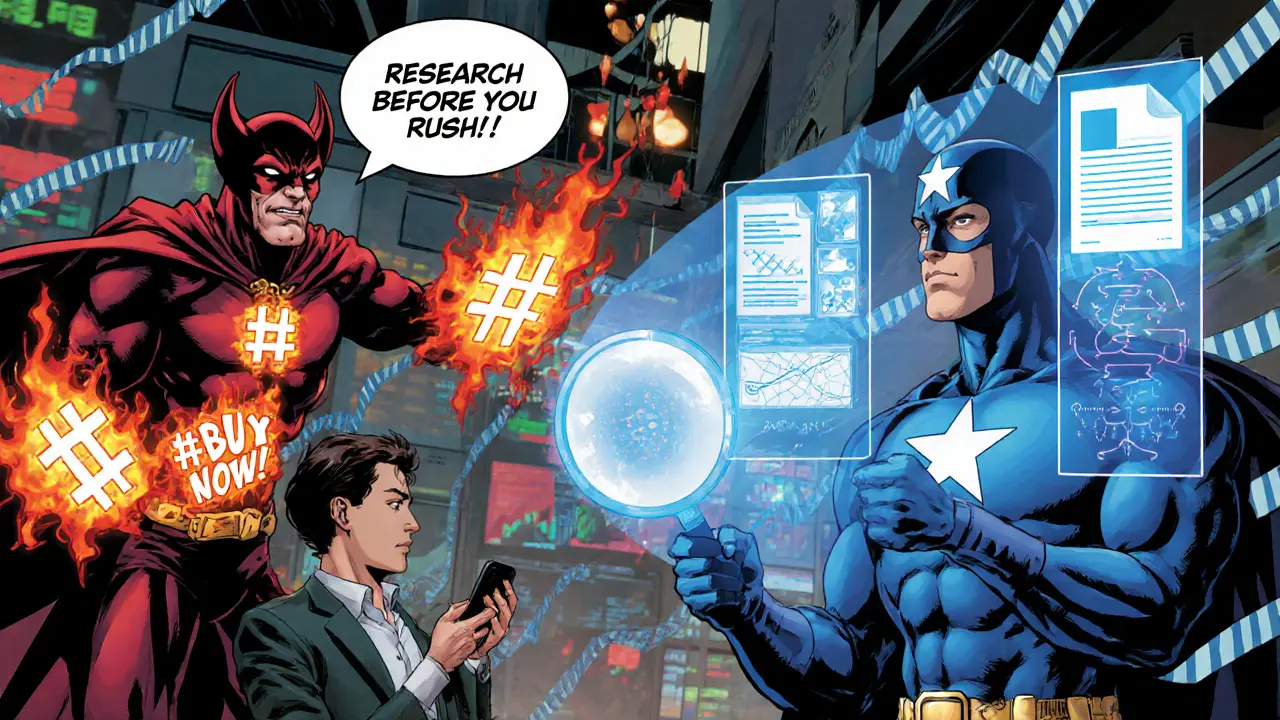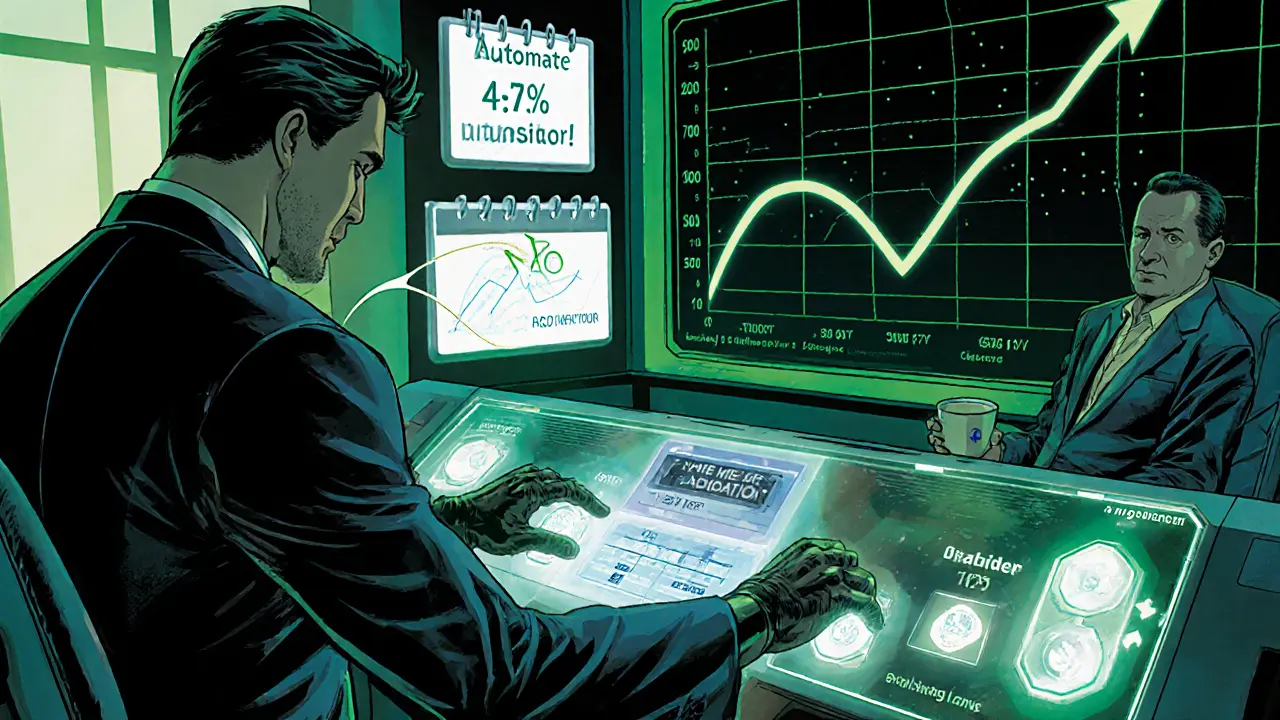DCA Fee Impact Calculator
Calculate Your Fee Impact
Why This Matters
As mentioned in the article, "Because DCA involves frequent small purchases, fees add up fast. A 0.5% fee on a $50 purchase eats $0.25 each time – over a year that's $13—enough to shave off a few percent of returns."
High fees can significantly reduce your returns over time. This calculator shows how fees impact your investment growth.
Choose platforms with fees ≤0.1% for recurring buys to maximize your returns.
Your Fee Impact Analysis
When it comes to systematic crypto investing, Dollar Cost Averaging (DCA) is a strategy that spreads purchases of an asset over regular intervals using the same dollar amount each time. It sounds simple, but many investors stumble over hidden traps that turn a smart plan into a costly mess. Below you’ll find the most common mistakes, why they happen, and practical steps to keep your DCA game strong.
1. Ignoring Diversification Leads to Concentration Risk
Diversification is the practice of spreading your money across different assets to reduce the impact of any single failure. New crypto fans often pour every DCA dollar into Bitcoin or the latest meme coin because it’s what the hype feeds them. That concentration defeats the whole point of DCA, which is to smooth out volatility.
- Stick to at least three to five coins with distinct use‑cases (store of value, smart contracts, DeFi, layer‑2, etc.).
- Allocate a fixed percentage to each, e.g., 40% BTC, 30% ETH, 20% a diversified DeFi token, 10% high‑risk experimental coin.
- Re‑balance yearly to keep the percentages in line with your risk tolerance.
2. Skipping Research and Buying on Hype
Many DCA investors rely on trending Twitter hashtags or friends’ stories instead of digging into the fundamentals. Without a clear understanding of why a coin exists, you might keep buying a project that never delivers.
Do a quick check before you add a token to your DCA list:
- Read the whitepaper or official docs - does the project solve a real problem?
- Look at the development activity on GitHub - are developers actively building?
- Check the tokenomics - is the supply inflationary or deflationary, and how does that affect price?
3. Letting Emotions Drive the Amount You Invest
One of the biggest pitfalls is the "chasing quick gains" trap. When the market surges, you feel the urge to double your weekly DCA amount, thinking you’ll lock in gains. The opposite happens - you end up buying at peak prices and later selling low when fear hits.
Set a fixed amount once and stick to it. If you really want to add extra cash, treat it as a separate lump‑sum trade, not a change to your DCA cadence.
4. Being Too Rigid During Prolonged Bear Markets
Consistency is key, but blind rigidity can hurt. If the market stays depressed for months, you might consider a modest reduction in weekly spend or shifting part of the allocation to more stable assets (like stablecoins) while still keeping the core habit alive.
Think of DCA as a flexible framework, not a set of iron‑clad rules.
5. Overlooking Trading Fees and Platform Costs
Because DCA involves frequent small purchases, fees add up fast. A 0.5% fee on a $50 purchase eats $0.25 each time - over a year that’s $13-enough to shave off a few percent of returns.
Choose platforms with low or zero maker/taker fees for recurring buys, or use exchange‑offered “dollar‑cost‑averaging” features that bundle multiple purchases into one transaction.
6. Forgetting the Real Purpose of DCA - Averaging Down
When the market spikes, your DCA purchases actually raise your average cost instead of lowering it. This is the opposite of what DCA is most powerful at - buying more when prices are low.
Some investors solve this by setting a rule: if the price moves up more than 10% from the last purchase, skip the next scheduled buy and resume when it dips back.

7. Over‑Allocating Crypto in Your Overall Portfolio
Studies from CoinShares suggest keeping crypto between 4% and 7.5% of total investable assets. If you pour 20% of your net worth into DCA, a sudden crash could jeopardize your emergency fund.
Run the “can I lose this money?” test: if losing the entire crypto stash would force you to dip into rent or groceries, you’ve allocated too much.
8. Ignoring Exit Strategies and Risk Management
DCA is great for entering positions, but you need a plan for when to exit or protect gains. Many traders forget to set stop‑losses or define a target allocation once crypto reaches a certain percentage of their portfolio.
Typical exit ideas:
- Sell a portion when the crypto share of your net worth hits the upper bound of your allocation range.
- Use a trailing stop‑loss of 15‑20% to lock in upside while still allowing upside moves.
- Plan a “review date” (e.g., every six months) to decide whether to keep DCA or pause.
9. Not Automating the Process
Manual DCA invites missed weeks, inconsistent amounts, and emotional interference. Most reputable exchanges let you set up recurring purchases with exact dates and dollar values. Activate notifications so you know each trade executed.
10. Analysis Paralysis - Waiting for the Perfect Moment
Some newcomers delay starting DCA until they think the market has bottomed out. The reality is you’ll never catch the perfect dip. Starting now, even with a modest amount, is better than endless waiting.
Quick Fix Comparison Table
| Mistake | Simple Fix |
|---|---|
| Concentrating on 1-2 coins | Build a 4‑5 coin basket with varied use‑cases |
| Buying on hype | Do a 3‑point fundamentals check before adding a token |
| Changing weekly amount based on market mood | Set a fixed dollar amount; treat extra cash as a separate trade |
| Skipping fee‑aware platform selection | Choose exchanges with ≤0.1% fees for recurring buys |
| No exit or risk plan | Define allocation caps and trailing stop‑loss levels |
| Manual execution | Enable automated recurring purchases and set alerts |
Putting It All Together - A Sample DCA Blueprint
Here’s a concise, actionable template you can copy‑paste into your notes:
- Set Allocation: 5% of total investable assets.
- Select Coins: BTC (40%), ETH (30%), DeFi token (20%), High‑risk altcoin (10%).
- Choose Platform: Low‑fee exchange with auto‑buy feature.
- Weekly Amount: $100 split per percentages above.
- Fee Check: Ensure total cost per trade ≤0.2%.
- Adjustment Rule: If price rises >10% since last buy, skip next buy.
- Risk Guardrails: If crypto share exceeds 7.5% of portfolio, sell back to target.
- Review Cycle: Every 6 months - adjust coin list, amounts, and re‑balance.

Final Thoughts - Stay Disciplined, Stay Flexible
DCA works because it removes the need to time the market. The real magic shows up when you protect the strategy from the very human errors that try to sneak in. Keep your plan simple, diversify wisely, automate the grind, watch fees, and always have a clear exit rule. Follow these habits and you’ll let the crypto roller‑coaster ride you instead of the other way around.
How often should I rebalance my DCA crypto portfolio?
A good rule of thumb is to review your allocation twice a year. If any coin drifts more than 2‑3% away from its target weight, rebalance to keep risk in check.
Do I need a separate wallet for DCA purchases?
Not necessarily. Many exchanges let you keep funds in their custodial wallet and automate buys. If you prefer self‑custody, set up a hardware wallet and transfer the weekly amount there before each purchase.
What’s the ideal percentage of my net worth to allocate to crypto?
Experts at CoinShares recommend between 4% and 7.5% of total investable assets. Adjust the range based on your risk tolerance and financial goals.
Can I use DCA on stablecoins?
Yes, stablecoins are a low‑volatility way to keep cash on‑chain while you wait for a better entry point. Just be mindful of any yield‑bearing options and their associated risks.
How do fees impact long‑term DCA returns?
Fees chip away at returns each time you buy. Over five years, a 0.5% fee per trade can reduce total gains by 5‑10% compared to a zero‑fee environment, so always prioritize low‑cost platforms.


Jenna Em
October 21, 2025 AT 09:20They say DCA is the safe path, but have you ever wondered who benefits when the little investors keep buying? The hidden hands behind the exchanges sit back while you pay fees on every dime. Every time you click “buy”, a silent algorithm nudges the market a little higher. The truth is a loop: you fund the system that can, one day, turn on you. Stay aware, question the pattern.
Stephen Rees
October 26, 2025 AT 00:27While the surface looks calm, the underlying mechanics are anything but. It's as if the market whispers a secret that only the big players hear. You might think you’re just following a plan, but the plan itself may be part of a larger design. Keep your eyes open, even if the noise seems harmless.
Katheline Coleman
October 30, 2025 AT 15:34Thank you for the comprehensive overview. The structured approach you have outlined is both practical and educational. I appreciate the emphasis on diversification and fee awareness, as these are often overlooked by newcomers. Your inclusion of a concrete DCA blueprint will certainly aid many readers in implementing a disciplined strategy. I look forward to further discussion on risk mitigation techniques.
Amy Kember
November 4, 2025 AT 06:40I like the clear steps
the table is helpful
just remember to check fees each month
Evan Holmes
November 8, 2025 AT 21:47Just another DCA hype, nothing new.
Isabelle Filion
November 13, 2025 AT 12:54Ah, the age‑old advice to “just automate and forget.” How original. As if the mere act of setting a recurring purchase magically shields you from market volatility. One would think that paying a few basis points in fees while blindly accumulating would be the pinnacle of financial genius. The sarcasm is thin, but the point remains: execution without thought is a recipe for mediocrity.
Patrick Day
November 18, 2025 AT 04:00Look, they want you to think DCA is safe so they can keep your money flowing into their platforms. Every buy order is a little data point they harvest, feeding algorithms that push the price just enough to profit the insiders. It’s all a big experiment, and we’re the lab rats.